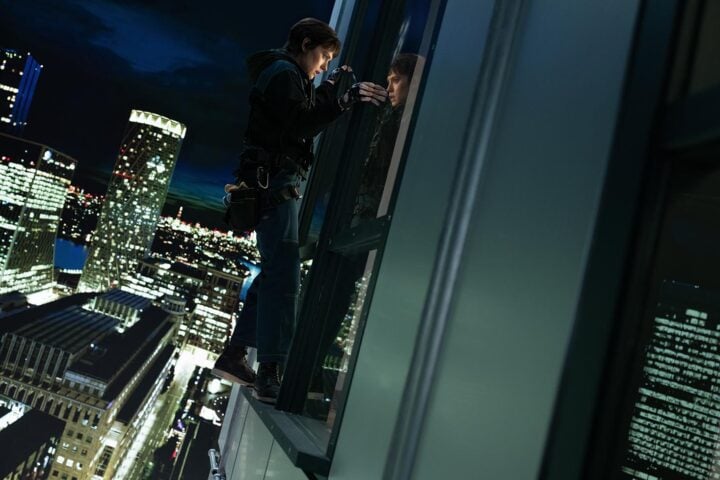Hélène Cattet and Bruno Forzani waste no time establishing the freely associative rhythms of their latest film, Reflection in a Dead Diamond. Its opening pair of images, of a fizzing drink dissolving into ocean waves as they wash over a bikini-clad young woman, herald an orgiastic symphony of sensory overload. Right out of the gate, the filmmakers’ filtering of a James Bond-esque espionage tale through a grindhouse sensibility exists in such a state of emphatic stimulation that each shot feels punctuated with an exclamation point.
Cattet and Forzani, who stitch Reflection in a Dead Diamond together from a seemingly endless array of money shots and stylistic flourishes, never take their foot off the accelerator. It feels like an impossible velocity to maintain, so a big question hanging over the film is when a moment will come when viewers will be able to catch their breaths. The answer comes when the closing credits roll—and remarkably without any detour into self-indulgent flights of fancy.
Yet Cattet and Forzani’s ambitious audiovisual spectacle amounts to more than just a feature-length YouTube compilation of cool cinematography and sound effects. Reflection in a Dead Diamond’s energy works in service of a demolition derby of widely observed conventions around visual and narrative storytelling. This cumulative experience overwhelms all modes of perception to erode the barriers across timelines and between the film’s dueling fictions.
If there’s any knock against the film, it’s that the breakneck pace doesn’t allow for a user-friendly entry point into its subject matter. Cattet and Forzani’s technical virtuosity almost works against them in that it’s easy to miss the forest for the trees in their frenetic montage. Their maximalist aesthetic keeps providing such constant hits of dopamine and adrenaline to viewers that it’s difficult to access higher brain functions needed to follow characters and story. But this film provides less a plotline to grab onto so much as it presents a wavelength to ride.
Reflection in a Dead Diamond, though, has more to offer than just vibes. Over time, it emerges that an old man, John D. (Fabio Testi), once worked as a superspy—or maybe just played one. While otherwise content to relax in his retirement along the French Riviera, the sensations aroused by his new neighbor keep reminding him of his illustrious and ignominious past. Cattet and Forzani replicate this mental process for the audience with furious cutting and evocative sound effects that make his subjectivity all-encompassing.
John’s debonair younger self (Yannick Renier) begins occupying more real estate as the film goes on, and his increasing prevalence ushers in true delirium around the details of the character’s work. Cattet and Forzani never clarify the extent to which espionage was his true career or whether he just acted in genre films. Scenes suggesting both possibilities intermingle as reality and fiction collapse in John’s mind, suggesting that he’s chosen to process his life as a spy thriller. This fragmentation even comes complete with studio execs guiding him against frequent foes, especially the metallically-nailed Serpentik (Thi Mai Nguyen).
Cattet and Forzani utilize this subject matter involving moviemaking to pay loving homage to slick espionage capers and pulpy B-movies alike. But they do so through broad inspirational touchstones like the art of optical illusions popular during the spy genre’s height; an encyclopedic knowledge of movie minutiae isn’t necessary to appreciate the filmmakers’ allusions. Reflection in a Dead Diamond extends a welcoming hand to cinephiles as Cattet and Forzani explode the form from within. Building from a familiar cinematic language, the filmmakers then create an exciting new syntax. The end result is a destabilizing hall of mirrors where half the walls are projecting a film instead of reflecting a participant.
Cattet and Forzani create a total cinema within Reflection of a Dead Diamond—not because they manage to replicate reality but because they manage to eradicate it. As their plunge into an experiential world becomes increasingly more fragmented, the boundary between fiction and reality grows blurrier for both John and the audience. All that’s reliable in such a whirlwind is the immediacy of image and sound in a given moment, and the film wastes not a single second throughout its expansion reshaping of perception. This is the brain on cinema.
Since 2001, we've brought you uncompromising, candid takes on the world of film, music, television, video games, theater, and more. Independently owned and operated publications like Slant have been hit hard in recent years, but we’re committed to keeping our content free and accessible—meaning no paywalls or fees.
If you like what we do, please consider subscribing to our Patreon or making a donation.



